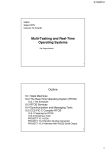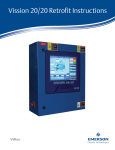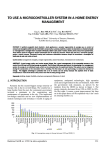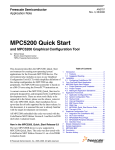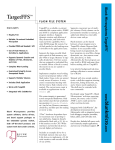Download Multi-Tasking and Real-Time Operating Systems
Transcript
CHAPTER 10
Multi-Tasking and Real-Time
Operating Systems
Nearly all microcontroller-based systems perform more than one activity. For example,
a temperature monitoring system is made up of three tasks that normally repeat after a
short delay, namely:
Task 1 Reads the temperature
Task 2 Formats the temperature
Task 3 Displays the temperature
More complex systems may have many complex tasks. In a multi-tasking system,
numerous tasks require CPU time, and since there is only one CPU, some form of
organization and coordination is needed so each task has the CPU time it needs. In
practice, each task takes a very brief amount of time, so it seems as if all the tasks are
executing in parallel and simultaneously.
Almost all microcontroller-based systems work in real time. A real-time system is a
time responsive system that can respond to its environment in the shortest possible time.
Real time does not necessarily mean the microcontroller should operate at high speed.
What is important in a real-time system is a fast response time, although high speed can
help. For example, a real-time microcontroller-based system with various external
switches is expected to respond immediately when a switch is activated or some other
event occurs.
A real-time operating system (RTOS) is a piece of code (usually called the kernel) that
controls task allocation when the microcontroller is operating in a multi-tasking
www.newnespress.com
516
Chapter 10
environment. RTOS decides, for instance, which task to run next, how to coordinate the
task priorities, and how to pass data and messages among tasks.
This chapter explores the basic principles of multi-tasking embedded systems and gives
examples of an RTOS used in simple projects. Multi-tasking code and RTOS are
complex and wide topics, and this chapter describes the concepts pertaining to these
tools only briefly. Interested readers should refer to the many books and papers
available on operating systems, multi-tasking systems, and RTOS.
There are several commercially available RTOS systems for PIC microcontrollers.
At the time of writing, mikroC language did not provide a built-in RTOS. Two popular
high-level RTOS systems for PIC microcontrollers are Salvo (www.pumpkin.com),
which can be used from a Hi-Tech PIC C compiler, and the CCS (Customer Computer
Services) built-in RTOS system. In this chapter, the example RTOS projects are based
on the CCS (www.ccsinfo.com) compiler, one of the popular PIC C compilers
developed for the PIC16 and PIC18 series of microcontrollers.
10.1 State Machines
State machines are simple constructs used to perform several activities, usually in a
sequence. Many real-life systems fall into this category. For example, the operation of a
washing machine or a dishwasher is easily described with a state machine construct.
Perhaps the simplest method of implementing a state machine construct in C is to use a
switch-case statement. For example, our temperature monitoring system has three tasks,
named Task 1, Task 2, and Task 3 as shown in Figure 10.1. The state machine
implementation of the three tasks using switch-case statements is shown in Figure 10.2.
The starting state is 1, and each task increments the state number by one to select the
next state to be executed. The last state selects state 1, and there is a delay at the end of
the switch-case statement. The state machine construct is executed continuously inside
an endless for loop.
Task 1
Task 2
Task 3
Figure 10.1: State machine implementation
www.newnespress.com
Multi-Tasking and Real-Time Operating Systems
517
for(;;)
{
state = 1;
switch (state)
{
CASE 1:
implement TASK 1
state++;
break;
CASE 2:
implement TASK 2
state++;
break;
CASE 3:
implement TASK 3
state = 1;
break;
}
Delay_ms(n);
}
Figure 10.2: State machine implementation in C
In many applications, the states need not be executed in sequence. Rather, the next state
is selected by the present state either directly or based on some condition. This is shown
in Figure 10.3.
for(;;)
{
state = 1;
switch (state)
{
CASE 1:
implement TASK 1
state = 2;
break;
CASE 2:
implement TASK 2
state = 3;
break;
CASE 3:
implement TASK 3
state = 1;
break;
}
Delay_ms(n);
}
Figure 10.3: Selecting the next state from the current state
www.newnespress.com
518
Chapter 10
State machines, although easy to implement, are primitive and have limited application.
They can only be used in systems which are not truly responsive, where the task
activities are well-defined and the tasks are not prioritized.
Moreover, some tasks may be more important than others. We may want some
tasks to run whenever they become eligible. For example, in a manufacturing
plant, a task that sets off an alarm when the temperature is too hot must be
run. This kind of implementation of tasks requires a sophisticated system like
RTOS.
10.2 The Real-Time Operating System (RTOS)
Real-time operating systems are built around a multi-tasking kernel which controls the
allocation of time slices to tasks. A time slice is the period of time a given task has
for execution before it is stopped and replaced by another task. This process, also
known as context switching, repeats continuously. When context switching occurs, the
executing task is stopped, the processor registers are saved in memory, the processor
registers of the next available task are loaded into the CPU, and the new task begins
execution. An RTOS also provides task-to-task message passing, synchronization of
tasks, and allocation of shared resources to tasks.
The basic parts of an RTOS are:
Scheduler
RTOS services
Synchronization and messaging tools
10.2.1
The Scheduler
A scheduler is at the heart of every RTOS, as it provides the algorithms to select the
tasks for execution. Three of the more common scheduling algorithms are:
Cooperative scheduling
Round-robin scheduling
Preemptive scheduling
www.newnespress.com
Multi-Tasking and Real-Time Operating Systems
519
Cooperative scheduling is perhaps the simplest scheduling algorithm available. Each
task runs until it is complete and gives up the CPU voluntarily. Cooperative scheduling
cannot satisfy real-time system needs, since it cannot support the prioritization of tasks
according to importance. Also, a single task may use the CPU too long, leaving too little
time for other tasks. And the scheduler has no control of the various tasks’ execution
time. A state machine construct is a simple form of a cooperative scheduling technique.
In round-robin scheduling, each task is assigned an equal share of CPU time (see
Figure 10.4). A counter tracks the time slice for each task. When one task’s time slice
completes, the counter is cleared and the task is placed at the end of the cycle. Newly
added tasks are placed at the end of the cycle with their counters cleared to 0. This, like
cooperative scheduling, is not very useful in a real-time system, since very often some
tasks take only a few milliseconds while others require hundreds of milliseconds or
more.
TASK 1
TASK 2
TASK 3
TASK 1
TASK 2
Figure 10.4: Round-robin scheduling
Preemptive scheduling is considered a real-time scheduling algorithm. It is prioritybased, and each task is given a priority (see Figure 10.5). The task with the highest
priority gets the CPU time. Real-time systems generally support priority levels ranging
from 0 to 255, where 0 is the highest priority and 255 is the lowest.
Priority
TASK 3
TASK 2
TASK 1
TASK 2
TASK 1
Time
Figure 10.5: Preemptive scheduling
www.newnespress.com
520
Chapter 10
In some real-time systems where more than one task can be at the same priority level,
preemptive scheduling is mixed with round-robin scheduling. In such cases, tasks at
higher priority levels run before lower priority ones, and tasks at the same priority level
run by round-robin scheduling. If a task is preempted by a higher priority task, its run
time counter is saved and then restored when it regains control of the CPU.
In some systems a strict real-time priority class is defined where tasks above this class
may run to completion (or run until a resource is not available) even if there are other
tasks at the same priority level.
In a real-time system a task can be in any one of the following states (see Figure 10.6):
Ready to run
Running
Blocked
When a task is first created, it is usually ready to run and is entered in the task list.
From this state, subject to the scheduling algorithm, the task can become a running task.
According to the conditions of preemptive scheduling, the task will run if it is the
highest priority task in the system and is not waiting for a resource.
A running task becomes a blocked task if it needs a resource that is not available. For
example, a task may need data from an A/D converter and is blocked until it is
Ready
Highest
priority
Resource available
but not highest
priority
Not the highest
priority
Unblocked and
highest priority
Blocked
Resource not available
Figure 10.6: Task states
www.newnespress.com
Running
Multi-Tasking and Real-Time Operating Systems
521
available. Once the resource can be accessed, the blocked task becomes a running task
if it is the highest priority task in the system, otherwise it moves to the ready state. Only
a running task can be blocked. A ready task cannot be blocked.
When a task moves from one state to another, the processor saves the running task’s
context in memory, loads the new task’s context from memory, and then executes the
new instructions as required.
The kernel usually provides an interface to manipulate task operations. Typical task
operations are:
Creating a task
Deleting a task
Changing the priority of a task
Changing the state of a task
10.3 RTOS Services
RTOS services are utilities provided by the kernel that help developers create real-time
tasks efficiently. For example, a task can use time services to obtain the current date and
time. Some of these services are:
Interrupt handling services
Time services
Device management services
Memory management services
Input-output services
10.4 Synchronization and Messaging Tools
Synchronization and messaging tools are kernel constructs that help developers create
real-time applications. Some of these services are:
Semaphores
Event flags
www.newnespress.com
522
Chapter 10
Mailboxes
Pipes
Message queues
Semaphores are used to synchronize access to shared resources, such as common data
areas. Event flags are used to synchronize the intertask activities. Mailboxes, pipes, and
message queues are used to send messages among tasks.
10.5 CCS PIC C Compiler RTOS
The CCS PIC C compiler is one of the popular C compilers for the PIC16 and PIC18
series of microcontrollers. In addition to their PIC compilers, Customer Computer
Services offers PIC in-circuit emulators, simulators, microcontroller programmers, and
various development kits. The syntax of the CCS C language is slightly different from
that of the mikroC language, but readers who are familiar with mikroC should find CCS
C easy to use.
CCS C supports a rudimentary multi-tasking cooperative RTOS for the PIC18 series of
microcontrollers that uses their PCW and PCWH compilers. This RTOS allows a PIC
microcontroller to run tasks without using interrupts. When a task is scheduled to run,
control of the processor is given to that task. When the task is complete or does not
need the processor any more, control returns to a dispatch function, which gives control
of the processor to the next scheduled task. Because the RTOS does not use interrupts
and is not preemptive, the user must make sure that a task does not run forever.
Further details about the RTOS are available in the compiler’s user manual.
The CCS language provides the following RTOS functions in addition to the normal C
functions:
rtos_run() initiates the operation of RTOS. All task control operations are
implemented after calling this function.
rtos_terminate() terminates the operation of RTOS. Control returns to the
original program without RTOS. In fact, this function is like a return from
rtos_run().
rtos_enable() receives the name of a task as an argument. The function enables the
task so function rtos_run() can call the task when its time is due.
www.newnespress.com
Multi-Tasking and Real-Time Operating Systems
523
rtos_disable() receives the name of a task as an argument. The function disables the
task so it can no longer be called by rtos_run() unless it is re-enabled by calling
rtos_enable().
rtos_ yield(), when called from within a task, returns control to the dispatcher. All
tasks should call this function to release the processor so other tasks can utilize the
processor time.
rtos_msg_send() receives a task name and a byte as arguments. The function sends
the byte to the specified task, where it is placed in the task’s message queue.
rtos_msg_read() reads the byte located in the task’s message queue.
rtos_msg_ poll() returns true if there is data in the task’s message queue. This
function should be called before reading a byte from the task’s message queue.
rtos_signal() receives a semaphore name and increments that semaphore.
rtos_wait() receives a semaphore name and waits for the resource associated with the
semaphore to become available. The semaphore count is then decremented so the
task can claim the resource.
rtos_await() receives an expression as an argument, and the task waits until the
expression evaluates to true.
rtos_overrun() receives a task name as an argument, and the function returns true if
that task has overrun its allocated time.
rtos_stats() returns the specified statistics about a specified task. The statistics can be
the minimum and maximum task run times and the total task run time. The task name
and the type of statistics are specified as arguments to the function.
10.5.1
Preparing for RTOS
In addition to the preceding functions, the #use rtos() preprocessor command must be
specified at the beginning of the program before calling any of the RTOS functions. The
format of this preprocessor command is:
#use rtos(timer¼n, minor_cycle¼m)
where timer is between 0 and 4 and specifies the processor timer that will be used by
the RTOS, and minor_cycle is the longest time any task will run. The number entered
here must be followed by s, ms, us, or ns.
www.newnespress.com
524
Chapter 10
In addition, a statistics option can be specified after the minor_cycle option, in which
case the compiler will keep track of the minimum and maximum processor times the
task uses at each call and the task’s total time used.
10.5.2
Declaring a Task
A task is declared just like any other C function, but tasks in a multi-tasking application
do not have any arguments and do not return any values. Before a task is declared, a
#task preprocessor command is needed to specify the task options. The format of this
preprocessor command is:
#task(rate¼n, max¼m, queue¼p)
where rate specifies how often the task should be called. The number specified must
be followed by s, ms, us, or ns. max specifies how much processor time a task will
use in one execution of the task. The time specifed here must be equal to or less than
the time specified by minor_cycle. queue is optional and if present specifies the
number of bytes to be reserved for the task to receive messages from other tasks.
The default value is 0.
In the following example, a task called my_ticks is every 20ms and is expected to use no
more than 100ms of processor time. This task is specified with no queue option:
#task(rate¼20ms, max¼100ms)
void my_ticks()
{
...........
...........
}
PROJECT 10.1—LEDs
In the following simple RTOS-based project, four LEDs are connected to the lower half
of PORTB of a PIC18F452-type microcontroller. The software consists of four tasks,
where each task flashes an LED at a different rate:
Task 1, called task_B0, flashes the LED connected to port RB0 at a rate
of 250ms.
Task 2, called task_B1, flashes the LED connected to port RB1 at a rate
of 500ms.
www.newnespress.com
Multi-Tasking and Real-Time Operating Systems
525
Task 3, called task_B2, flashes the LED connected to port RB2 once a second.
Task 4, called task_B3, flashes the LED connected to port RB3 once every two
seconds.
Figure 10.7 shows the circuit diagram of the project. A 4MHz crystal is used as the
clock. PORTB pins RB0–RB3 are connected to the LEDs through current limiting
resistors.
Figure 10.7: Circuit diagram of the project
The software is based on the CCS C compiler, and the program listing (RTOS1.C) is
given in Figure 10.8. The main program is at the end of the program, and inside the
main program PORTB pins are declared as outputs and RTOS is started by calling
function rtos_run().
The file that contains CCS RTOS declarations should be included at the beginning of
the program. The preprocessor command #use delay tells the compiler that we are using
www.newnespress.com
526
Chapter 10
///////////////////////////////////////////////////////////////////////////////////////////////////////////////////////////////////
//
//
SIMPLE RTOS EXAMPLE
//
---------------------------------//
// This is a simple RTOS example. 4 LEDs are connected to lower half of
// PORTB of a PIC18F452 microcontroller. The program consists of 4
// tasks:
//
// Task task_B0 flashes the LED connected to port RB0 every 250ms.
// Task task_B1 flashes the LED connected to port RB1 every 500ms.
// Task task_B2 flashes the LED connected to port RB2 every second
// Task task_B3 flashes the LED connected to port RB3 every 2 seconds.
//
// The microcontroller is operated from a 4MHz crystal
//
// Programmer:
Dogan Ibrahim
// Date:
September, 2007
// File:
RTOS1.C
//
///////////////////////////////////////////////////////////////////////////////////////////////////////////////////////////////////
#include "C:\NEWNES\PROGRAMS\rtos.h"
#use delay (clock=4000000)
//
// Define which timer to use and minor_cycle for RTOS
//
#use rtos(timer=0, minor_cycle=10ms)
//
// Declare TASK 1 - called every 250ms
//
#task(rate=250ms, max=10ms)
void task_B0()
{
output_toggle(PIN_B0);
}
//
// Declare TASK 2 - called every 500ms
//
#task(rate=500ms, max=10ms)
void task_B1()
{
output_toggle(PIN_B1);
}
// Toggle RB0
// Toggle RB1
//
// Declare TASK 3 - called every second
Figure 10.8: Program listing of the project
www.newnespress.com
Multi-Tasking and Real-Time Operating Systems
527
//
#task(rate=1s, max=10ms)
void task_B2()
{
output_toggle(PIN_B2);
}
// Toggle RB2
//
// Declare TASK 4 - called every 2 seconds
//
#task(rate=2s, max=10ms)
void task_B3()
{
output_toggle(PIN_B3);
}
//
// Start of MAIN program
//
void main()
{
set_tris_b(0);
rtos_run();
}
// Toggle RB3
// Configure PORTB as outputs
// Start RTOS
Figure 10.8: (Cont’d)
a 4MHz clock. Then the RTOS timer is declared as Timer 0, and minor_cycle time is
declared as 10ms using the preprocessor command #use rtos.
The program consists of four similar tasks:
task_B0 flashes the LED connected to RB0 at a rate of 250ms. Thus, the LED is
ON for 250ms, then OFF for 250ms, and so on. CCS statement output_toggle is
used to change the state of the LED every time the task is called. In the CCS
compiler PIN_B0 refers to port pin RB0 of the microcontroller.
task_B1 flashes the LED connected to RB1 at a rate of 500ms as described.
task_B2 flashes the LED connected to RB2 every second as described.
Finally, task_B3 flashes the LED connected to RB3 every two seconds as
described.
www.newnespress.com
528
Chapter 10
The program given in Figure 10.8 is a multi-tasking program where the LEDs flash
independently of each other and concurrently.
PROJECT 10.2—Random Number Generator
In this slightly more complex RTOS project, a random number between 0 and 255 is
generated. Eight LEDs are connected to PORTB of a PIC18F452 microcontroller. In
addition, a push-button switch is connected to bit 0 of PORTD (RD0), and an LED is
connected to bit 7 of PORTD (RD7).
Three tasks are used in this project: Live, Generator, and Display.
Task Live runs every 200ms and flashes the LED on port pin RD7 to indicate
that the system is working.
Task Generator increments a variable from 0 to 255 continuously and checks
the status of the push-button switch. When the push-button switch is pressed,
the value of the current count is sent to task Display using a messaging queue.
Task Display reads the number from the message queue and sends the received
byte to the LEDs connected to PORTB. Thus, the LEDs display a random
pattern every time the push button is pressed.
Figure 10.9 shows the project’s block diagram. The circuit diagram is given in
Figure 10.10. The microcontroller is operated from a 4MHz crystal.
LIVE
(flashes every 200ms)
PIC
18F452
Push-button
switch
PORTB
LEDs
Figure 10.9: Block diagram of the project
www.newnespress.com
Multi-Tasking and Real-Time Operating Systems
529
Figure 10.10: Circuit diagram of the project
The program listing of the project (RTOS2.C) is given in Figure 10.11. The main part of
the program is in the later portion, and it configures PORTB pins as outputs. Also,
bit 0 of PORTD is configured as input and other pins of PORTD are configured as
outputs.
Timer 0 is used as the RTOS timer, and the minor_cycle is set to 1s. The program
consists of three tasks:
Task Live runs every 200ms and flashes the LED connected to port pin RD7.
This LED indicates that the system is working.
Task Generator runs every millisecond and increments a byte variable called
count continuously. When the push-button switch is pressed, pin 0 of PORTD
(RD0) goes to logic 0. When this happens, the current value of count is sent to
task Display using RTOS function call rtos_msg_send(display, count), where
www.newnespress.com
530
Chapter 10
///////////////////////////////////////////////////////////////////////////////////////////////////////////////////////////
//
//
SIMPLE RTOS EXAMPLE - RANDOM NUMBER GENERATOR
//
-----------------------------------------------------------------------------------//
// This is a simple RTOS example. 8 LEDs are connected to PORTB
// of a PIC18F452 microcontroller. Also, a push-button switch is
// connected to port RC0 of PORTC, and an LED is connected to port
// RC7 of the microcontroller. The push-button switch is normally at logic 1.
//
// The program consists of 3 tasks called "Generator", "Display", and "Live".
//
// Task "Generator" runs in a loop and increments a counter from 0 to 255.
// This task also checks the state of the push-button switch. When the
// push-button switch is pressed, the task sends the value of the count to the
// "Display" task using messaging passing mechanism. The “Display” task
// receives the value of count and displays it on the PORTB LEDs.
//
// Task "Live" flashes the LED connected to port RC7 at a rate of 250ms.
// This task is used to indicate that the system is working and is ready for
// the user to press the push-button.
//
// The microcontroller is operated from a 4MHz crystal
//
// Programmer:
Dogan Ibrahim
// Date:
September, 2007
// File:
RTOS2.C
//
//////////////////////////////////////////////////////////////////////////////////
#include "C:\NEWNES\PROGRAMS\rtos.h"
#use delay (clock=4000000)
int count;
//
// Define which timer to use and minor_cycle for RTOS
//
#use rtos(timer=0, minor_cycle=1ms)
//
// Declare TASK "Live" - called every 200ms
// This task flashes the LED on port RC7
//
#task(rate=200ms, max=1ms)
void Live()
{
output_toggle(PIN_D7);
}
//
Figure 10.11: Program listing of the project
www.newnespress.com
Multi-Tasking and Real-Time Operating Systems
// Declare TASK "Display" - called every 10ms
//
#task(rate=10ms, max=1ms, queue=1)
void Display()
{
if(rtos_msg_poll() > 0)
{
output_b(rtos_msg_read());
}
}
// Is there a message ?
// Send to PORTB
//
// Declare TASK "Generator" - called every millisecond
//
#task(rate=1ms, max=1ms)
void Generator()
{
count++;
if(input(PIN_D0) == 0)
{
rtos_msg_send(Display,count);
}
}
//
// Start of MAIN program
//
void main()
{
set_tris_b(0);
set_tris_d(1);
rtos_run();
}
531
// Increment count
// Switch pressed ?
// send a message
// Configure PORTB as outputs
// RD0=input, RD7=output
// Start RTOS
Figure 10.11: (Cont’d)
Display is the name of the task where the message is sent and count is the byte
sent.
Task Display runs every 10ms. This task checks whether there is a message
in the queue. If so, the message is extracted using RTOS function call
rtos_msg_read(), and the read byte is sent to the LEDs connected to PORTB.
Thus, the LEDs display the binary value of count as the switch is pressed. The
message queue should be checked by using function rtos_msg_poll(), as trying
to read the queue without any bytes in the queue may freeze the program.
www.newnespress.com
532
Chapter 10
PROJECT 10.3—Voltmeter with RS232 Serial Output
In this RTOS project, which is more complex than the preceding ones, the voltage is
read using an A/D converter and then sent over the serial port to a PC. The project
consists of three tasks: Live, Get_voltage, and To_RS232.
Task Live runs every 200ms and flashes an LED connected to port RD7 of the
microcontroller to indicate that the system is working.
Task Get_voltage reads channel 0 of the A/D converter where the voltage to be
measured is connected. The read value is formatted and then stored in a
variable. This task runs every two seconds.
Task To_RS232 reads the formatted voltage and sends it over the RS232 line to
a PC every second.
Figure 10.12 shows the block diagram of the project. The circuit diagram is given in
Figure 10.13. A PIC18F8520-type microcontroller with a 10MHz crystal is used in this
project (though any PIC18F-series microcontroller can be used). The voltage to be
measured is connected to analog port AN0 of the microcontroller. The RS232 TX output
of the microcontroller (RC6) is connected to a MAX232-type RS232-level converter chip
and then to the serial input of a PC (e.g., COM1) using a 9-pin D-type connector. Port pin
RD7 is connected to an LED to indicate whether the project is working.
Live LED
PIC
18F8520
Voltage to be
measured
PC
RS232
level
converter
Figure 10.12: Block diagram of the project
The program listing (RTOS3.C) of the project is given in Figure 10.14. At the beginning
of the program, the A/D is defined as 10 bits, the clock is defined as 10MHz, and the
RS232 speed is defined as 2400 baud. The RTOS timer and the minor_cycle are then
defined using the #use rtos preprocessor command.
www.newnespress.com
Multi-Tasking and Real-Time Operating Systems
533
Figure 10.13: Circuit diagram of the project
In the main part of the program PORTD is configured as output and all PORTD pins are
cleared. Then PORTA is configured as input (RA0 is the analog input), the
microcontroller’s analog inputs are configured, the A/D clock is set, and the A/D
channel 0 is selected (AN0). The RTOS is then started by calling function rtos_run().
The program consists of three tasks:
Task Live runs every 200ms and flashes an LED connected to port pin RD7 of
the microcontroller to indicate that the project is working.
Task Get_voltage reads the analog voltage from channel 0 (pin RA0 or AN0) of
the microcontroller. The value is then converted into millivolts by multiplying
by 5000 and dividing by 1024 (in a 10-bit A/D there are 1024 quantization
levels, and when working with a reference voltage of þ5V, each quantization
level corresponds to 5000/1024mV). The voltage is stored in a global variable
called Volts.
www.newnespress.com
534
Chapter 10
///////////////////////////////////////////////////////////////////////////////////////////////////////////////////////////////////
//
//
SIMPLE RTOS EXAMPLE - VOLTMETER WITH RS232 OUTPUT
//
--------------------------------------------------------------------------------------//
// This is a simple RTOS example. Analog voltage to be measured (between 0V
// and +5V) is connected to analog input AN0 of a PIC18F8520 type
// microcontroller. The microcontroller is operated from a 10MHz crystal. In
// addition, an LED is connected to port in RD7 of the microcontroller.
//
// RS232 serial output of the mirocontroller (RC6) is connected to a MAX232
// type RS232 voltage level converter chip. The output of this chip can be
// connected to the serial input of a PC (e.g., COM1) so that the measured
// voltage can be seen on the PC screen.
//
// The program consists of 3 tasks called "live", "Get_voltage", and “To_RS232”.
//
// Task "Live" runs every 200ms and it flashes the LED conencted to port pin
// RD7 of the microcontroller to indicate that the program is running and is
// ready to measure voltages.
//
// task "Get_voltage" reads analog voltage from port AN0 and then converts
// the voltage into millivolts and stores in a variable called Volts.
//
// Task "To_RS232" gets the measured voltage, converts it into a character
// array and then sends to the PC over the RS232 serial line. The serial line
// is configured to operate at 2400 Baud (higher Baud rates can also be used if
// desired).
//
// Programmer:
Dogan Ibrahim
// Date:
September, 2007
// File:
RTOS3.C
//
///////////////////////////////////////////////////////////////////////////////////////////////////////////////////////////////////
#include <18F8520.h>
#device adc=10
#use delay (clock=10000000)
#use rs232(baud=2400,xmit=PIN_C6,rcv=PIN_C7)
unsigned int16 adc_value;
unsigned int32 Volts;
//
// Define which timer to use and minor_cycle for RTOS
//
#use rtos(timer=0, minor_cycle=100ms)
//
// Declare TASK "Live" - called every 200ms
Figure 10.14: Program listing of the project
www.newnespress.com
Multi-Tasking and Real-Time Operating Systems
// This task flashes the LED on port RD7
//
#task(rate=200ms, max=1ms)
void Live()
{
output_toggle(PIN_D7);
}
//
// Declare TASK "Get_voltage" - called every 10ms
//
#task(rate=2s, max=100ms)
void Get_voltage()
{
adc_value = read_adc();
Volts = (unsigned int32)adc_value*5000;
Volts = Volts / 1024;
}
//
// Declare TASK "To_RS232" - called every millisecond
//
#task(rate=2s, max=100ms)
void To_RS232()
{
printf("Measured Voltage = %LumV\n\r",Volts);
}
//
// Start of MAIN program
//
void main()
{
set_tris_d(0);
output_d(0);
set_tris_a(0xFF);
setup_adc_ports(ALL_ANALOG);
setup_adc(ADC_CLOCK_DIV_32);
set_adc_channel(0);
delay_us(10);
rtos_run();
}
535
// Toggle RD7 LED
// Read A/D value
// Voltage in mV
// send to RS232
// PORTD all outputs
// Clear PORTD
// PORTA all inputs
// A/D ports
// A/D clock
// Select channel 0 (AN0)
// Start RTOS
Figure 10.14: (Cont’d)
www.newnespress.com
536
Chapter 10
Task To_RS232 reads the measured voltage from common variable Volts and
sends it to the RS232 port using the C printf statement. The result is sent in the
following format:
Measured voltage ¼ nnnn mV
The HyperTerminal program is run on the PC to get an output from the program.
A typical screen output is shown in Figure 10.15.
Figure 10.15: Typical output from the program
Using a Semaphore
The program given in Figure 10.14 is working and displays the measured voltage
on the PC screen. This program can be improved slightly by using a semaphore to
synchronize the display of the measured voltage with the A/D samples. The modified
www.newnespress.com
Multi-Tasking and Real-Time Operating Systems
537
/////////////////////////////////////////////////////////////////////////////////////////////////////////////////////////////////
//
//
SIMPLE RTOS EXAMPLE - VOLTMETER WITH RS232 OUTPUT
//
--------------------------------------------------------------------------------------//
// This is a simple RTOS example. Analog voltage to be measured (between 0V
// and +5V) is connected to analog input AN0 of a PIC18F8520 type
// microcontroller. The microcontroller is operated from a 10MHz crystal. In
// addition, an LED is connected to port in RD7 of the microcontroller.
//
// RS232 serial output of the mirocontroller (RC6) is connected to a MAX232
// type RS232 voltage level converter chip. The output of this chip can be
// connected to the serial input of a PC (e.g., COM1) so that the measured
// voltage can be seen on the PC screen.
//
// The program consists of 3 tasks called "live", "Get_voltage", and "To_RS232".
//
// Task "Live" runs every 200ms and it flashes the LED connected to port RD7
// of the microcontroller to indicate that the program is running and is ready to
// measure voltages.
//
// task "Get_voltage" reads analog voltage from port AN0 and then converts the
// voltage into millivolts and stores in a variable called Volts.
//
// Task "To_RS232" gets the measured voltage and then sends to the PC over
// the RS232 serial line. The serial line is configured to operate at 2400 Baud
// (higher Baud rates can also be used if desired).
//
// In this modified program, a semaphore is used to synchronize
// the display of the measured value with the A/D samples.
//
// Programmer:
Dogan Ibrahim
// Date:
September, 2007
// File:
RTOS4.C
//
////////////////////////////////////////////////////////////////////////////////////////////////////////////////////////////////////
#include <18F8520.h>
#device adc=10
#use delay (clock=10000000)
#use rs232(baud=2400,xmit=PIN_C6,rcv=PIN_C7)
unsigned int16 adc_value;
unsigned int32 Volts;
int8 sem;
//
// Define which timer to use and minor_cycle for RTOS
//
#use rtos(timer=0, minor_cycle=100ms)
Figure 10.16: Modified program listing
(Continued)
www.newnespress.com
//
// Declare TASK "Live" - called every 200ms
// This task flashes the LED on port RD7
//
#task(rate=200ms, max=1ms)
void Live()
{
output_toggle(PIN_D7);
}
//
// Declare TASK "Get_voltage" - called every 10ms
//
#task(rate=2s, max=100ms)
void Get_voltage()
{
rtos_wait(sem);
adc_value = read_adc();
Volts = (unsigned int32)adc_value*5000;
Volts = Volts / 1024;
rtos_signal(sem);
}
//
// Declare TASK "To_RS232" - called every millisecond
//
#task(rate=2s, max=100ms)
void To_RS232()
{
rtos_wait(sem);
printf("Measured Voltage = %LumV\n\r",Volts);
rtos_signal(sem);
}
//
// Start of MAIN program
//
void main()
{
set_tris_d(0);
output_d(0);
set_tris_a(0xFF);
setup_adc_ports(ALL_ANALOG);
setup_adc(ADC_CLOCK_DIV_32);
set_adc_channel(0);
delay_us(10);
sem = 1;
rtos_run();
// decrement semaphore
// Read A/D value
// Voltage in mV
// increment semaphore
// Decrement semaphore
// Send to RS232
// Increment semaphore
// PORTD all outputs
// Clear PORTD
// PORTA all inputs
// A/D ports
// A/D clock
// Select channel 0 (AN0)
// Semaphore is 1
// Start RTOS
}
Figure 10.16: (Cont’d)
www.newnespress.com
// Toggle RD7 LED
Multi-Tasking and Real-Time Operating Systems
539
program (RTOS4.C) is given in Figure 10.16. The operation of the new program
is as follows:
The semaphore variable (sem) is set to 1 at the beginning of the program.
Task Get_voltage decrements the semaphore (calls rtos_wait) variable so
that task To_RS232 is blocked (semaphore variable sem ¼ 0) and cannot
send data to the PC. When a new A/D sample is ready, the semaphore variable
is incremented (calls rtos_signal) and task To_RS232 can continue. Task
To_RS232 then sends the measured voltage to the PC and increments the
semaphore variable to indicate that it had access to the data. Task Get_voltage
can then get a new sample. This process is repeated forever.
www.newnespress.com

























